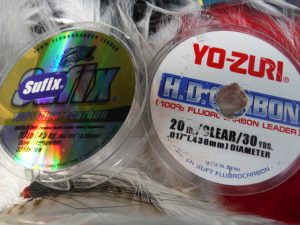By Nick Simonson
While the number of people engaged in fishing activities has declined in recent years, it’s safe to say that those who remain in the ranks of anglers throughout the upper Midwest are armed with uncountable lures, amazing watercraft and technology that rides the cutting edge. As a result, this concentrated core of well-equipped sportsmen is able to make up for the lack of pressure that previous throngs of anglers would have produced, making fish just as wary and intelligent about the offerings being thrown at them as they were in past seasons. For heavily-pursued fish like muskies and walleyes, along with fish in clear water lakes, getting down to them with a natural offering often requires some stealth.
 Thankfully, along with the advancements in other areas of angling technology has come the proliferation of fluorocarbon lines. Fluorocarbon (or simply “fluoro” in angler-speak) first came about as a line option in the 1970s, but the cost of manufacturing it limited its uses until production outfits found cheaper ways of producing the line. As such, it was limited to saltwater leader applications until the mid-1990s when line manufacturers began using new technologies to produce it cheaper and more effectively, lowering the price of the material. Still now, fluoro is around two or three times the cost of standard monofilament line, simply due to the cost of making the line, however, it’s advantages – specifically as a leader material – make a spool of it a smart addition to any tacklebox, regardless of species angled for.
Thankfully, along with the advancements in other areas of angling technology has come the proliferation of fluorocarbon lines. Fluorocarbon (or simply “fluoro” in angler-speak) first came about as a line option in the 1970s, but the cost of manufacturing it limited its uses until production outfits found cheaper ways of producing the line. As such, it was limited to saltwater leader applications until the mid-1990s when line manufacturers began using new technologies to produce it cheaper and more effectively, lowering the price of the material. Still now, fluoro is around two or three times the cost of standard monofilament line, simply due to the cost of making the line, however, it’s advantages – specifically as a leader material – make a spool of it a smart addition to any tacklebox, regardless of species angled for.
The magic of fluorocarbon is in its light refraction qualities, which are about equal to that of water, rendering the line material nearly invisible to fish. In addition to going unseen by wary walleyes, or highly-pressured muskies, fluoro is more abrasion-resistant than monofilament and does not absorb water as quickly as the standard fishing line material. Moreover, fluorocarbon is about twice as dense as mono line, allowing it to sink faster in the water column with a cast offering. Going unseen, and being able to stand up to the teeth of bigger predator species, fluoro leaders can be somewhat larger and thicker than standard leaders, including steel, and it is quickly becoming the material of choice for muskie anglers on highly-pressured lakes, where the slightest hint of something amiss can turn off big fish.
With the pros always come some cons, and fluoro is no different. Stiffer and less supple than monofilament, fluoro can be difficult to knot, requiring added attention to not only the connection point with a lure but also where it is tied in to the main line when used as a leader. It is imperative to moisten each knot thoroughly and make sure the wraps line up to prevent weakening or breaking of fluorocarbon line. Connect leaders to the main line with a uni-to-uni knot and use a well-aligned Trilene or palomar knot to tie on lures, and pay attention to the finished product, making sure there is no line warp from the pressure of the knot cinching down into position. If there is, it is better to cut and retie to be assured of a secure connection.
With the devoted putting additional pressure on fish and lakes across the region clearing rapidly from not only better watershed practices such as sanitary sewers replacing septic systems on the shore but also the unfortunate introduction of invasive species like zebra mussels to the water, adapting to the conditions requires added stealth to provide natural-looking offerings to all species. Fluorocarbon fills that role for anglers nicely, and with a little practice and application on the water, its advantages become clear…in our outdoors.
